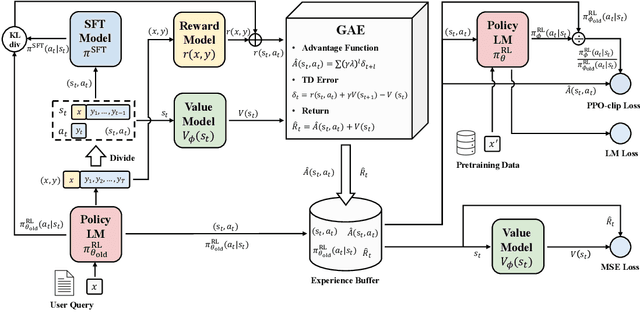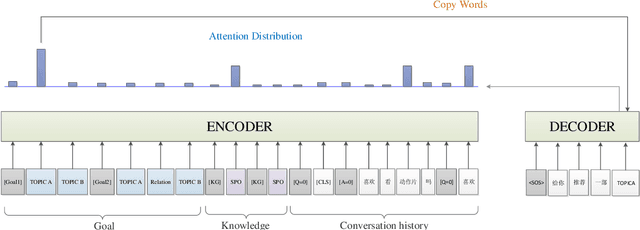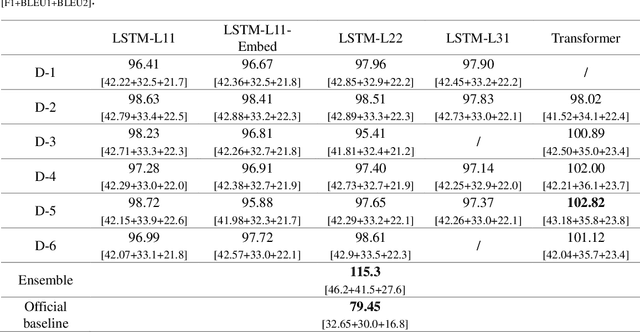Minghao Zhu
An Uncertainty-Weighted Decision Transformer for Navigation in Dense, Complex Driving Scenarios
Sep 16, 2025Abstract:Autonomous driving in dense, dynamic environments requires decision-making systems that can exploit both spatial structure and long-horizon temporal dependencies while remaining robust to uncertainty. This work presents a novel framework that integrates multi-channel bird's-eye-view occupancy grids with transformer-based sequence modeling for tactical driving in complex roundabout scenarios. To address the imbalance between frequent low-risk states and rare safety-critical decisions, we propose the Uncertainty-Weighted Decision Transformer (UWDT). UWDT employs a frozen teacher transformer to estimate per-token predictive entropy, which is then used as a weight in the student model's loss function. This mechanism amplifies learning from uncertain, high-impact states while maintaining stability across common low-risk transitions. Experiments in a roundabout simulator, across varying traffic densities, show that UWDT consistently outperforms other baselines in terms of reward, collision rate, and behavioral stability. The results demonstrate that uncertainty-aware, spatial-temporal transformers can deliver safer and more efficient decision-making for autonomous driving in complex traffic environments.
CleanPose: Category-Level Object Pose Estimation via Causal Learning and Knowledge Distillation
Feb 03, 2025



Abstract:Category-level object pose estimation aims to recover the rotation, translation and size of unseen instances within predefined categories. In this task, deep neural network-based methods have demonstrated remarkable performance. However, previous studies show they suffer from spurious correlations raised by "unclean" confounders in models, hindering their performance on novel instances with significant variations. To address this issue, we propose CleanPose, a novel approach integrating causal learning and knowledge distillation to enhance category-level pose estimation. To mitigate the negative effect of unobserved confounders, we develop a causal inference module based on front-door adjustment, which promotes unbiased estimation by reducing potential spurious correlations. Additionally, to further improve generalization ability, we devise a residual-based knowledge distillation method that has proven effective in providing comprehensive category information guidance. Extensive experiments across multiple benchmarks (REAL275, CAMERA25 and HouseCat6D) hightlight the superiority of proposed CleanPose over state-of-the-art methods. Code will be released.
MoTE: Reconciling Generalization with Specialization for Visual-Language to Video Knowledge Transfer
Oct 14, 2024Abstract:Transferring visual-language knowledge from large-scale foundation models for video recognition has proved to be effective. To bridge the domain gap, additional parametric modules are added to capture the temporal information. However, zero-shot generalization diminishes with the increase in the number of specialized parameters, making existing works a trade-off between zero-shot and close-set performance. In this paper, we present MoTE, a novel framework that enables generalization and specialization to be balanced in one unified model. Our approach tunes a mixture of temporal experts to learn multiple task views with various degrees of data fitting. To maximally preserve the knowledge of each expert, we propose \emph{Weight Merging Regularization}, which regularizes the merging process of experts in weight space. Additionally with temporal feature modulation to regularize the contribution of temporal feature during test. We achieve a sound balance between zero-shot and close-set video recognition tasks and obtain state-of-the-art or competitive results on various datasets, including Kinetics-400 \& 600, UCF, and HMDB. Code is available at \url{https://github.com/ZMHH-H/MoTE}.
Efficient Text-driven Motion Generation via Latent Consistency Training
May 05, 2024Abstract:Motion diffusion models have recently proven successful for text-driven human motion generation. Despite their excellent generation performance, they are challenging to infer in real time due to the multi-step sampling mechanism that involves tens or hundreds of repeat function evaluation iterations. To this end, we investigate a motion latent consistency Training (MLCT) for motion generation to alleviate the computation and time consumption during iteration inference. It applies diffusion pipelines to low-dimensional motion latent spaces to mitigate the computational burden of each function evaluation. Explaining the diffusion process with probabilistic flow ordinary differential equation (PF-ODE) theory, the MLCT allows extremely few steps infer between the prior distribution to the motion latent representation distribution via maintaining consistency of the outputs over the trajectory of PF-ODE. Especially, we introduce a quantization constraint to optimize motion latent representations that are bounded, regular, and well-reconstructed compared to traditional variational constraints. Furthermore, we propose a conditional PF-ODE trajectory simulation method, which improves the conditional generation performance with minimal additional training costs. Extensive experiments on two human motion generation benchmarks show that the proposed model achieves state-of-the-art performance with less than 10\% time cost.
CLIPose: Category-Level Object Pose Estimation with Pre-trained Vision-Language Knowledge
Feb 24, 2024Abstract:Most of existing category-level object pose estimation methods devote to learning the object category information from point cloud modality. However, the scale of 3D datasets is limited due to the high cost of 3D data collection and annotation. Consequently, the category features extracted from these limited point cloud samples may not be comprehensive. This motivates us to investigate whether we can draw on knowledge of other modalities to obtain category information. Inspired by this motivation, we propose CLIPose, a novel 6D pose framework that employs the pre-trained vision-language model to develop better learning of object category information, which can fully leverage abundant semantic knowledge in image and text modalities. To make the 3D encoder learn category-specific features more efficiently, we align representations of three modalities in feature space via multi-modal contrastive learning. In addition to exploiting the pre-trained knowledge of the CLIP's model, we also expect it to be more sensitive with pose parameters. Therefore, we introduce a prompt tuning approach to fine-tune image encoder while we incorporate rotations and translations information in the text descriptions. CLIPose achieves state-of-the-art performance on two mainstream benchmark datasets, REAL275 and CAMERA25, and runs in real-time during inference (40FPS).
Training Adversarial yet Safe Agent to Characterize Safety Performance of Highly Automated Vehicles
Feb 02, 2024Abstract:This paper focuses on safety performance testing and characterization of black-box highly automated vehicles (HAV). Existing testing approaches typically obtain the testing outcomes by deploying the HAV into a specific testing environment. Such a testing environment can involve various passively given testing strategies presented by other traffic participants such as (i) the naturalistic driving policy learned from human drivers, (ii) extracted concrete scenarios from real-world driving data, and (iii) model-based or data-driven adversarial testing methodologies focusing on forcing safety-critical events. The safety performance of HAV is further characterized by analyzing the obtained testing outcomes with a particular selected measure, such as the observed collision risk. The aforementioned testing practices suffer from the scarcity of safety-critical events, have limited operational design domain (ODD) coverage, or are biased toward long-tail unsafe cases. This paper presents a novel and informative testing strategy that differs from these existing practices. The proposal is inspired by the intuition that a relatively safer HAV driving policy would allow the traffic vehicles to exhibit a higher level of aggressiveness to achieve a certain fixed level of an overall safe outcome. One can specifically characterize such a HAV and traffic interactive strategy and use it as a safety performance indicator for the HAV. Under the proposed testing scheme, the HAV is evaluated under its full ODD with a reward function that represents a trade-off between safety and adversity in generating safety-critical events. The proposed methodology is demonstrated in simulation with various HAV designs under different operational design domains.
Fine-Grained Spatiotemporal Motion Alignment for Contrastive Video Representation Learning
Sep 01, 2023Abstract:As the most essential property in a video, motion information is critical to a robust and generalized video representation. To inject motion dynamics, recent works have adopted frame difference as the source of motion information in video contrastive learning, considering the trade-off between quality and cost. However, existing works align motion features at the instance level, which suffers from spatial and temporal weak alignment across modalities. In this paper, we present a \textbf{Fi}ne-grained \textbf{M}otion \textbf{A}lignment (FIMA) framework, capable of introducing well-aligned and significant motion information. Specifically, we first develop a dense contrastive learning framework in the spatiotemporal domain to generate pixel-level motion supervision. Then, we design a motion decoder and a foreground sampling strategy to eliminate the weak alignments in terms of time and space. Moreover, a frame-level motion contrastive loss is presented to improve the temporal diversity of the motion features. Extensive experiments demonstrate that the representations learned by FIMA possess great motion-awareness capabilities and achieve state-of-the-art or competitive results on downstream tasks across UCF101, HMDB51, and Diving48 datasets. Code is available at \url{https://github.com/ZMHH-H/FIMA}.
Secrets of RLHF in Large Language Models Part I: PPO
Jul 18, 2023



Abstract:Large language models (LLMs) have formulated a blueprint for the advancement of artificial general intelligence. Its primary objective is to function as a human-centric (helpful, honest, and harmless) assistant. Alignment with humans assumes paramount significance, and reinforcement learning with human feedback (RLHF) emerges as the pivotal technological paradigm underpinning this pursuit. Current technical routes usually include \textbf{reward models} to measure human preferences, \textbf{Proximal Policy Optimization} (PPO) to optimize policy model outputs, and \textbf{process supervision} to improve step-by-step reasoning capabilities. However, due to the challenges of reward design, environment interaction, and agent training, coupled with huge trial and error cost of large language models, there is a significant barrier for AI researchers to motivate the development of technical alignment and safe landing of LLMs. The stable training of RLHF has still been a puzzle. In the first report, we dissect the framework of RLHF, re-evaluate the inner workings of PPO, and explore how the parts comprising PPO algorithms impact policy agent training. We identify policy constraints being the key factor for the effective implementation of the PPO algorithm. Therefore, we explore the PPO-max, an advanced version of PPO algorithm, to efficiently improve the training stability of the policy model. Based on our main results, we perform a comprehensive analysis of RLHF abilities compared with SFT models and ChatGPT. The absence of open-source implementations has posed significant challenges to the investigation of LLMs alignment. Therefore, we are eager to release technical reports, reward models and PPO codes, aiming to make modest contributions to the advancement of LLMs.
A Formal Safety Characterization of Advanced Driver Assist Systems in the Car-Following Regime with Scenario-Sampling
Feb 17, 2022



Abstract:The capability to follow a lead-vehicle and avoid rear-end collisions is one of the most important functionalities for human drivers and various Advanced Driver Assist Systems (ADAS). Existing safety performance justification of the car-following systems either relies on simple concrete scenarios with biased surrogate metrics or requires a significantly long driving distance for risk observation and inference. In this paper, we propose a guaranteed unbiased and sampling efficient scenario-based safety evaluation framework inspired by the previous work on $\epsilon\delta$-almost safe set quantification. The proposal characterizes the complete safety performance of the test subject in the car-following regime. The performance of the proposed method is also demonstrated in challenging cases including some widely adopted car-following decision-making modules and the commercially available Openpilot driving stack by CommaAI.
Multiple Generative Models Ensemble for Knowledge-Driven Proactive Human-Computer Dialogue Agent
Jul 08, 2019



Abstract:Multiple sequence to sequence models were used to establish an end-to-end multi-turns proactive dialogue generation agent, with the aid of data augmentation techniques and variant encoder-decoder structure designs. A rank-based ensemble approach was developed for boosting performance. Results indicate that our single model, in average, makes an obvious improvement in the terms of F1-score and BLEU over the baseline by 18.67% on the DuConv dataset. In particular, the ensemble methods further significantly outperform the baseline by 35.85%.
 Add to Chrome
Add to Chrome Add to Firefox
Add to Firefox Add to Edge
Add to Edge